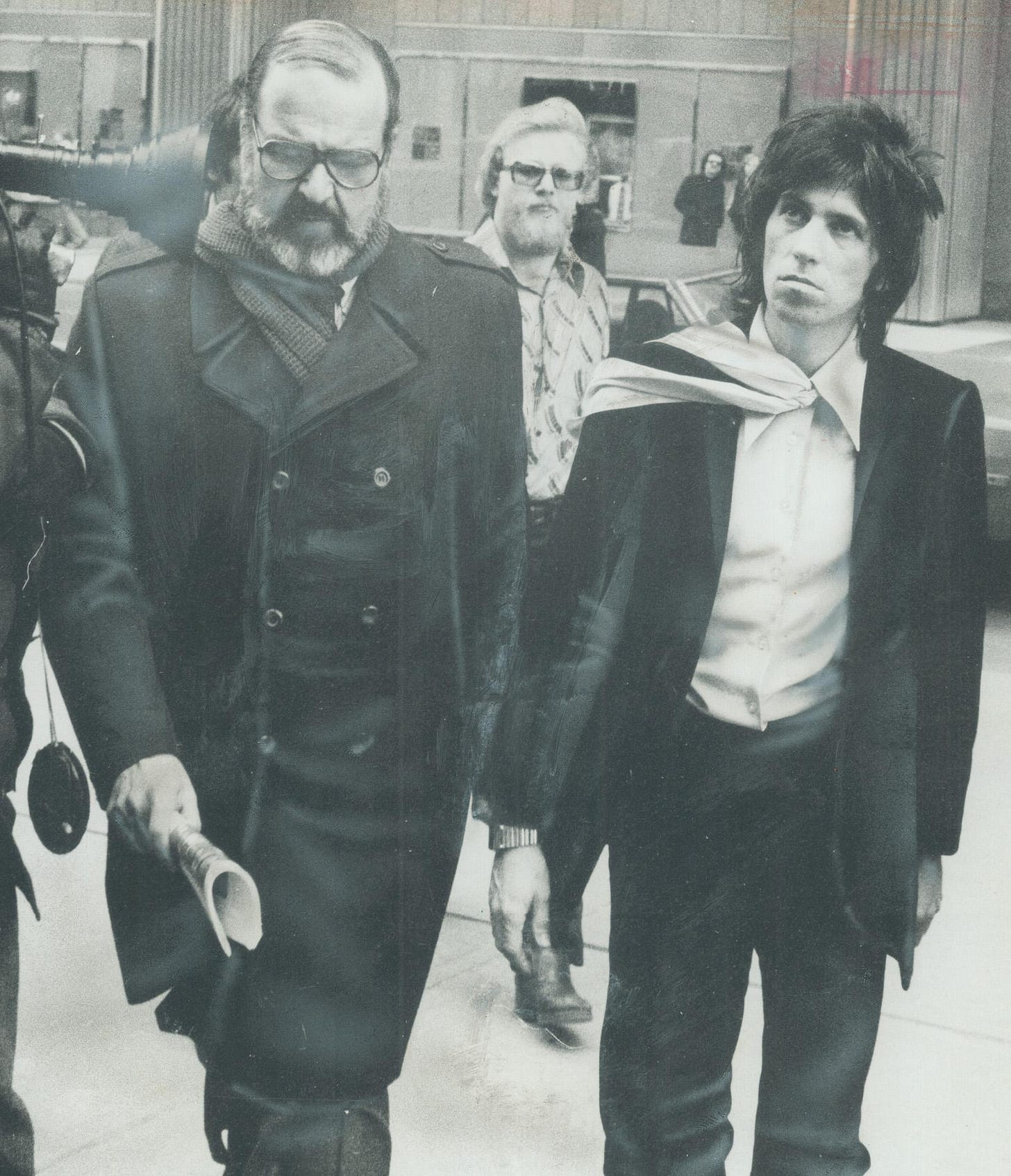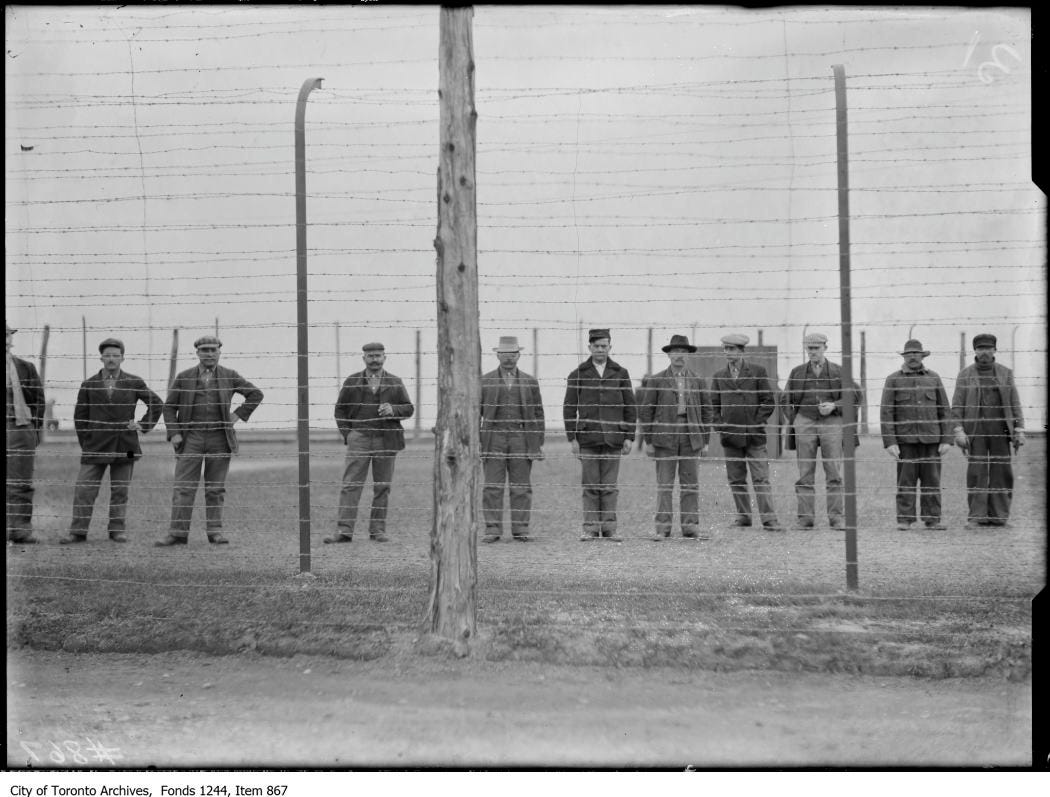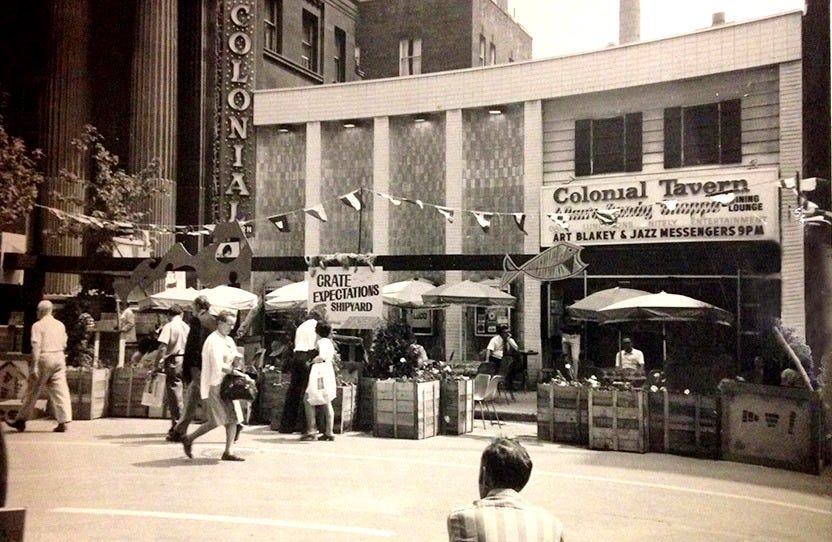How Ukranian-Canadians Were Treated During WWI
Plus the Toronto Patty Wars, Keith Richards, and more...
On this day in 1977, Keith Richards was arrested at the Harbour Castle hotel on the waterfront, charged with heroin possession. He was released on bail, but for a while his fate hung in the balance — and the future of The Rolling Stones with it as their guitarist faced the possibility of life in prison. So, it was all the more scandalous when the prime minster’s wife showed up at the secret rock shows they played at the El Mocambo later that week. When Margaret Trudeau stepped out of Mick Jagger’s limo on Spadina, it made front page news. And it was on her sixth wedding anniversary no less, with Pierre nowhere in sight. (In fact, it was such a landmark in our city’s romantic history that I gave it a chapter in The Toronto Book of Love.)
On this day in 2022, we’ll talk about the Toronto internment camp where Ukrainian-Canadians were imprisoned during the First World War, the fight over Jamaican patties that broke out in the 1980s, and so much more.
BUT FIRST! I want to thank everyone who switched over to a paid subscription this week. I can’t tell you how grateful I am. Your support means the world.
It’s a fantastic start, but in the coming days many more of you will have to follow in their footsteps to keep The Toronto History Weekly going. As I mentioned last week, I’m hoping to keep offering the newsletter for free, but it IS a ton of work, so I’ll be relying on the generosity of those of you who are able to pay a few dollars a month to support it.
In return, you’ll get some fun extras, like invitations to exclusive online lectures and the ability to comment on the newsletter and ask questions. You’ll also be supporting all the work I do in sharing stories about the history of Toronto and Canada.
To switch to a paid subscription, just click here:
If you’re not up for making the switch, don’t worry — you can still keep reading the newsletter for free. I’m thrilled to have you all reading along!
I especially understand if you feel like you’ve got more important places to send your money this week. You’ll find the donation page for the Ukrainian relief efforts of the United Nations refugee agency here. And the Canadian Red Cross’s Ukraine Humanitarian Crisis Appeal is here.
HOW UKRAINIAN-CANADIANS WERE TREATED DURING THE FIRST WORLD WAR
THE BIG STORY — It’s a heartbreaking week. And it feels like an absolutely absurd week to spend time writing a silly little newsletter. So, I thought at least I could spend some time this week teaching myself about the history of Ukrainian-Canadians so I could share some of it with you. After all, our country — as I just learned this afternoon — is home to the largest Ukrainian diaspora outside Russia. And, as I’ve long known, our government’s treatment of Ukrainian-Canadians was one of the most disturbing things that happened in our city during the First World War.
Just a couple of weeks into WWI, the Canadian government introduced the War Measures Act, giving itself sweeping powers to suspend civil liberties until after the conflict was over. Those new powers were quickly used against anyone with ties to “enemy nations.” And most of those targeted were Ukrainian-Canadians.
Ukraine wasn’t an independent country back then. It was split in two: part of the Ukrainian nation we know today was controlled by Russia (one of Canada’s allies at the time) while the rest of the country was part of the Austro-Hungarian Empire (who was fighting alongside Germany). That left people in Canada with Ukrainian heritage vulnerable to the xenophobia that swept our country during the war.
Tens of thousands of people living across the country were forced to register with the government. In Toronto, they were told to pay a visit to an office on Adelaide Street East, where they were reviewed and assessed by a judge. He took about 15 minutes to decide whether each person would be imprisoned or allowed to walk free after being added to a list of “enemy aliens.” Eighty thousand people were put on those lists — the majority of them people of Ukrainian descent. They were made to carry identity papers and regularly check in with the police
And those were the ones who passed the assessment. Thousands of others were sent off to one of the two dozen internment camps the government opened. The majority of those people were of Ukrainian heritage, too. Some had failed to pass the judges’ assessments, some had been arrested while trying to cross the border into the United States looking for work, some simply refused to go along with it at all. Families were torn apart. Life savings were seized. Prisoners were forced to work on construction projects, including building much of Banff National Park.
One of the internment camps was in Toronto. A military base on the Exhibition Grounds — the Stanley Barracks — had been repurposed to hold prisoners of war and civilian internees. There were reports of filthy conditions, of hunger strikes, and of the mental toll it was taking on the men held there — something we’d recognize today as PTSD.
It was six years before the last of the camps was finally shut down — more than eighteen months after the end of the war. And some of prisoners didn’t live to see that day. More than a hundred men died in the camps: some of disease, some killed while trying to escape, some killing themselves while suffering the terrible mental toll of their confinement. And some of those who did survive were deported upon their release.
The War Measures Act would be implemented twice more in Canadian history: during the Second World War, when Japanese-Canadians were imprisoned and deported by the tens of thousands, and during the October Crisis, when hundreds of people were arrested without charge.
It was in the wake of the October Crisis that rising calls for the War Measures Act convinced the government to review its powers. In 1988, it was finally repealed. It was replaced with the Emergency Act — used for the first time during the Ottawa convoy — to be a tool that wouldn’t override the civil liberties guaranteed by the Charter of Rights & Freedoms and the Canadian Bill of Rights, unlike what happened to so many Canadians during that terrible war a century ago.
READ MORE ABOUT THE STANLEY BARRACKS INTERNMENT CAMP
REMEMBERING THE TORONTO PATTY WARS
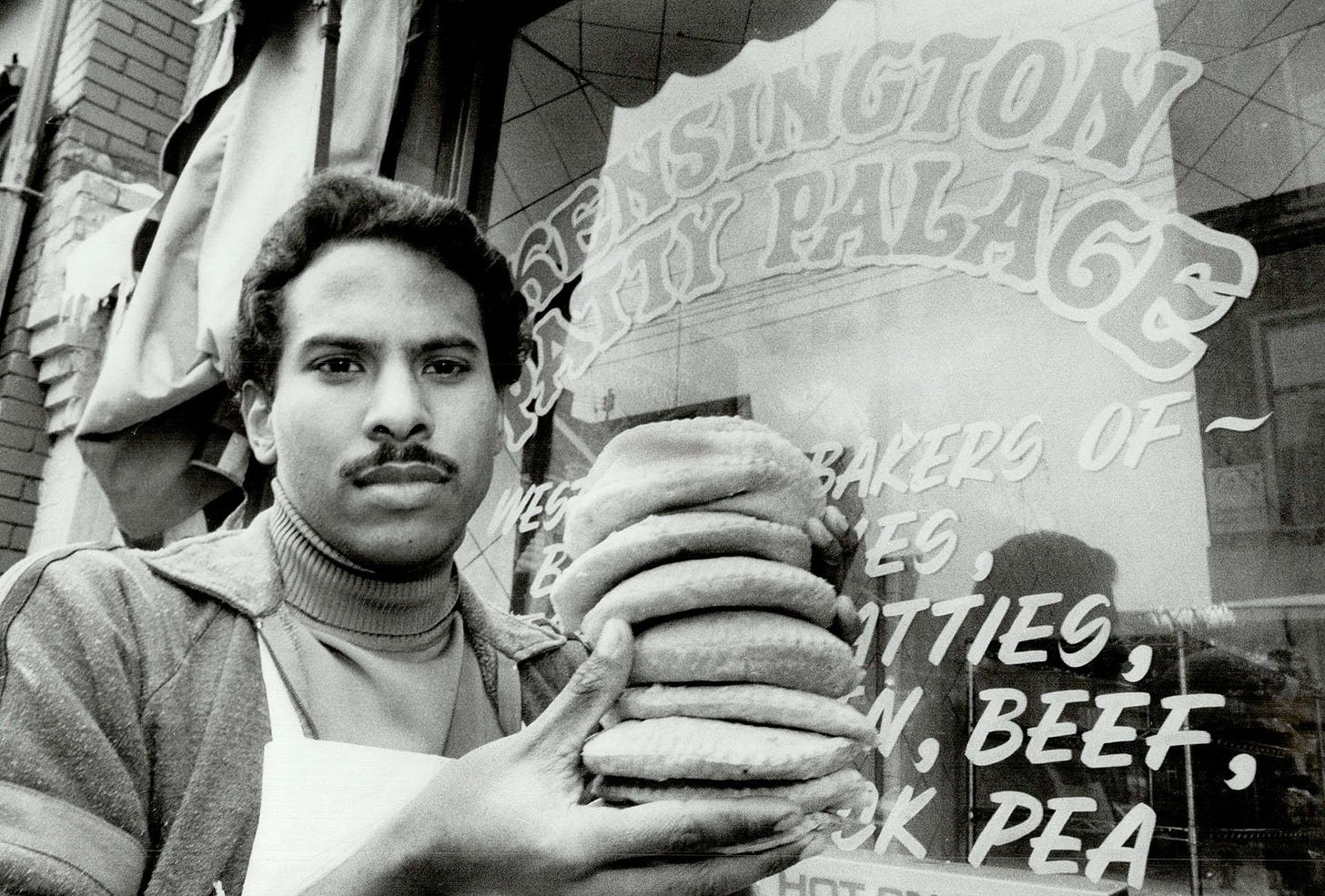
MEAT NEWS — It was, as so many of the most gripping stories in Canadian history are, centered around some paperwork. According to the federal government, the words “beef patty” had a very specific legal definition in the 1980s. That term was only allowed to refer to one thing: hamburger patties. Calling anything else a “beef patty” was illegal. And in the winter of 1985, the Canadian government decided it was time to enforce that definition.
Food inspectors began showing up on the doorsteps of Toronto’s Jamaican beef patty vendors, warning them they had to change their terminology. The vendors were told that while they might think they were selling beef patties, they were in fact selling “meat pies.” And the dangerous confusion this was surely sowing among Canadian consumers was completely unacceptable. If the vendors didn’t change their wording, they would be fined thousands of dollars.
These were small, family-owned businesses. They couldn’t afford the fines. Or the thousands of dollars it would take to change all their signage, menus and packaging — even register new business names. They were suddenly and unexpectedly in danger of losing their livelihoods.
“It’s what they now refer to as ‘institutionalized racism’,” Michael Davidson, manager of the Kensington Patty Palace, recently told the CBC.
Toronto had always been a more diverse place than those in power wanted to recognize. And it was now more multicultural than ever before, thanks in large part to changes to immigration laws introduced in the 1960s — making them less overtly racist. A growing number of new Canadians had been arriving from the Caribbean ever since. But Canadian laws — and the authorities who made and enforced them — were slow to reflect that diversity, holdovers from the days when Toronto still imagined itself to a staunchly British outpost of the Empire.
Toronto’s patty vendors were going to go down without a fight. They banded together in protest — with Davidson leading the charge. They went to the media, drummed up public support, convinced local politicians to support their cause… even the Jamaican consulate got involved. And it worked. The vendors forced the government to meet with them.
The Patty Summit was held on February 19th of that year. And a compromise was hammered out. The vendors wouldn’t be able to call their products “beef patties,” but they could call them “Jamaican patties”. That would keep them from having to change all their signage — and save their businesses in the process.
A few days later, the Kensington Patty Palace threw a big party to celebrate the peace deal. And that’s why every year on the anniversary of that party, our city celebrates again. February 23rd is officially recognized as Patty Day in Toronto.
ONE VERY COOL WINDOW
I STILL HAVEN’T GOTTEN OVER THE LOSS OF THE SILVER DOLLAR NEWS — One of the coolest things I saw on social media last week was a photo shared on Instagram. It was posted by the account that publicizes Jonny Dovercourt’s Any Night of the Week — a book about the musical history of our city.
The photo shows the window of the Tangerine Dream Gallery, an artist studio in the east end. It was recently displaying some work by Andrew M. Smith called “Toronto: Lost Music City” — miniature recreations of some of the most beloved music venues that have fallen under the wrecking ball in Toronto, including the Silver Dollar, the Big Bop and the Brown Derby.
Sadly, the pieces have already come down. But the photo is well worth the click:
QUICK LINKS
The best of everything else that’s new in Toronto’s past…
HIDDEN MUSEUM NEWS — Toronto’s Caribbean culture has given our city some of its greatest music. And that legacy is currently being highlighted with some super-cool historical artifacts at the tiny little music museum hidden away inside the Shopper’s Drug Mart at Yonge & Dundas Square. Read more.
OLD CITY LIBRARY BRANCH NEWS — The newest branch of the Toronto Public Library is getting a Wendat name recognizing the history of the area:


OLD CITY HALL HAS COMPANY NEWS — Turns out our old city hall isn’t the only old city hall built a very similar Richardsonian Romanesque style:





FASCINATING TWITTER THREAD NEWS — Eric Sehr does a great job on Twitter of diving into the history hidden within some of Toronto’s most fascinating archival photos. This week, it’s a shot taken from U of T in the 1850s:

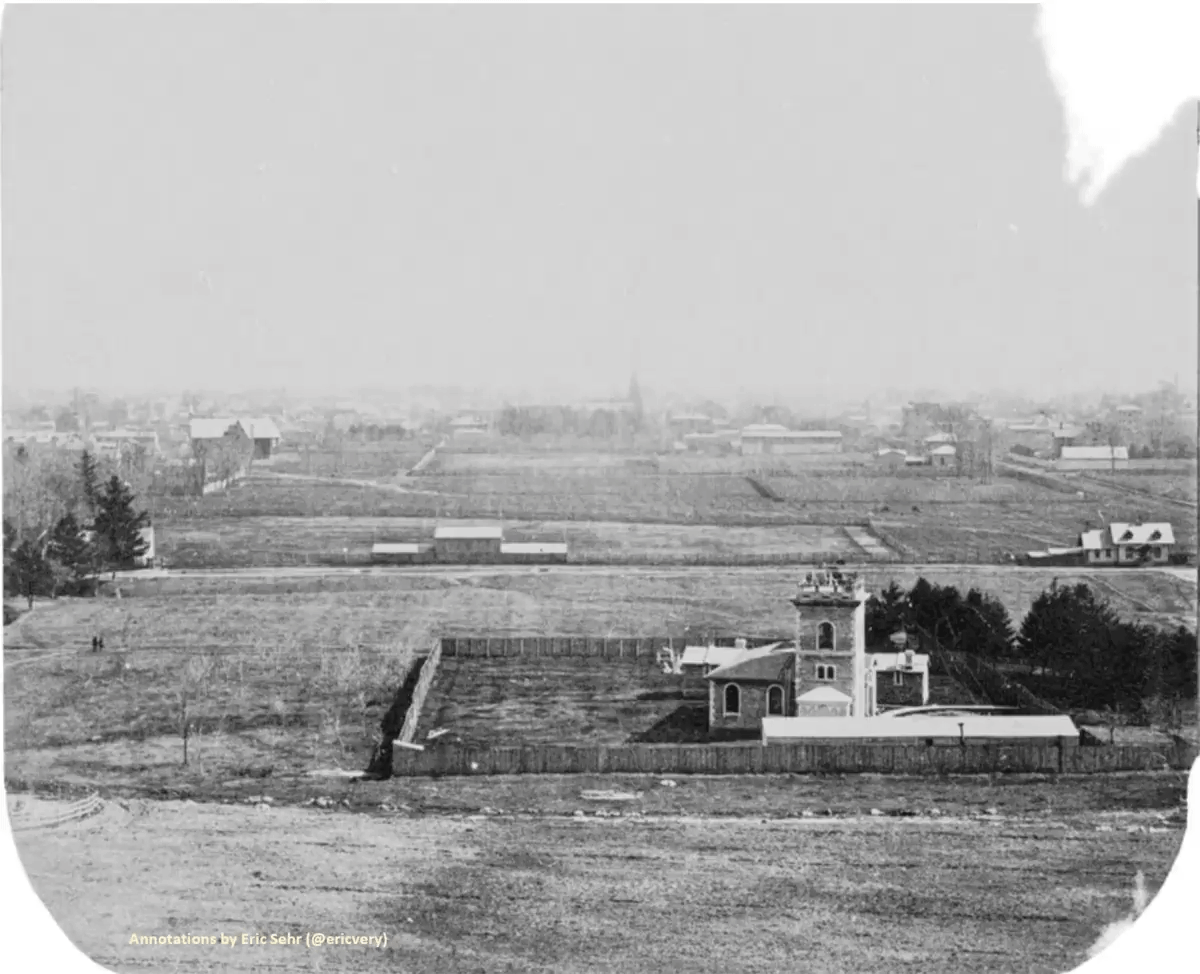
STREETCARS IN DISGUISE NEWS — When I paid a Toronto history-oriented visit to San Francisco a few years back, spotting the old TTC streetcar that rumbles along its tracks was one of the highlights. It’s one of many vintage trolleys the California city has in service. But, as I learned back then and Jack Landau points out this week, it’s not really a TTC streetcar at all. Read more.
EARTHA KITT IN TORONTO NEWS — Cheryl Thompson tries to solve the mystery of an intriguing photo Eartha Kitt taken during one of the singer’s visits to Toronto in the 1960s. Read more.
BLACK HISTORY IN THE CLASSROOM NEWS — Genelle Levy looks at how Black history is — and isn’t — being taught to students in Ontario schools. Read more.
BLACK HISTORY ON TELEVISION NEWS — NOW profiles The Porter, the new show about Black railway porters fighting for improved working conditions in the 1920s. It premiered this week. Read more.
BLACK HISTORY IN THE NEWS NEWS — TVO has put together a whole page of Black History Month-related stories and videos. Check it out.
MAGICIAN NEWS — I mentioned the Toronto magician/Broadway star/politician Doug Henning in last week’s newsletter. And in a happy coincidence, The Toronto Star just shared a story all about him. Read more.
DESMOND TUTU AT QUEEN’S PARK NEWS — Jamie Bradburn looks into the story of Desmond Tutu’s visit to Toronto during the struggle against apartheid. Read more.
In fact, this seems like a good time to share the quote Jamie uses to open his piece — from Tutu’s speech to the legislature at Queen’s Park:
“Sometimes you get the notion into your heart that what you do is insignificant; it cannot make a difference. Let me disabuse you of that notion. When people see a colossal problem, they wonder whether they could do anything to make a difference. They need to keep remembering what they are told about how you eat an elephant — one piece at a time. What you do, where you are, counts and makes a difference, if only to those who have their noses rubbed daily in the dust to know that the world cares.”
TORONTO HISTORY EVENTS
THE MISSING MILLIONAIRE
March 2 — 8pm — Online — Swansea Historical Society
Katie Daubs will speak about her book, The Missing Millionaire — The True Story of Ambrose Small and the City Obsessed with Finding Him.
“Ambrose Small was a mercurial Canadian theatre magnate who owned several Ontario-based theatres, including the since-demolished Grand Opera House which was once located on Adelaide Street in Toronto. The details of his bizarre life and career could easily fill several books! Small disappeared suddenly in December 1919, and his fate is still a mystery. His disappearance became a national news sensation in the early 1920s.”
Free, I believe!
TORONTO AT 188
March 6 — 7pm — Online — Town of York Historical Society
“Join us as we gather to celebrate the 188th anniversary of Toronto’s incorporation as a city.” Featuring presentations by Don Loucks — architect, urban designer, cultural heritage planner, and the co-author of Modest Hopes: Homes and Stories of Toronto’s Workers from the 1820s to the 1920 — and Morgan Campbell Ross, host of the Old Toronto series.
$32.84 for non-members, $27.54 for members, includes an 18.8% discount off the shop at TownofYork.com.
MY EVENTS
ADAM BUNCH PRESENTS: THE CIRCUS RIOT OF 1855
March 4 — 5pm — Online — The Toronto Guide Association of Toronto
On Friday afternoon, I’ll be giving an illustrated talk all about the strangest riot in Toronto history. It broke out in the summer of 1855, sparked by a brawl at a King Street brothel. When some rowdy clowns picked a fight with a battle-hardened crew of firefighters, they would quickly learn they’d made a terrible mistake. The circus performers found themselves facing off against Toronto’s powerful Orange Order in a bloody clash that revealed the fault lines that once violently divided our city.
$5 for non-members, free for members.




